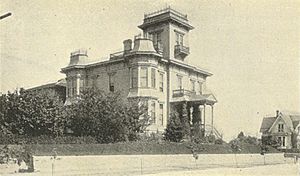Granville O. Haller facts for kids
Quick facts for kids
Granville Owen Haller
|
|
|---|---|
 |
|
| Born | January 31, 1819 York, Pennsylvania |
| Died | May 2, 1897 (aged 78) Seattle, Washington |
| Buried |
Lake View Cemetery
|
| Allegiance | United States of America |
| Service/ |
United States Army Union Army |
| Years of service | 1839–1863 1879–1882 |
| Rank | |
| Commands held | 23rd U.S. Infantry |
| Battles/wars | Seminole Wars |
Granville Owen Haller (born January 31, 1819 – died May 2, 1897) was an important U.S. Army officer. He was known for fighting in several wars, including the Mexican–American War and the American Civil War. After his military career, he became a successful businessman in Washington state.
Granville Haller's Early Life and Military Career
Granville Haller was born and grew up in York, Pennsylvania. After finishing school in 1838, he wanted to join the U.S. Military Academy. Even though he didn't get into West Point, he was still asked to join the Army. He became a lieutenant in the U.S. 4th Infantry Regiment.
Haller fought against Seminole people in Florida from 1840 to 1841. Later, he served bravely in the Mexican–American War. He took part in major battles like Monterrey and Veracruz. He was in the same army regiment as Ulysses S. Grant, who later became a U.S. President. Haller was especially recognized for his role in the Battle of Churubusco and the attack on Molino del Rey.
In 1852, the Army promoted Haller to major. The next year, he moved to Washington Territory, where he was stationed at Fort Dalles, Oregon. He also participated in the Northwest Indian wars of 1855-56. In 1859, he was involved in the San Juan Islands' Pig War, a peaceful disagreement over borders between the United States and Great Britain.
Haller in the Civil War and Later Years
When the American Civil War began, Haller was a commander for George B. McClellan's headquarters guard. He served during the Peninsula Campaign and the Maryland Campaign. In May 1863, he returned to his hometown of York, Pennsylvania, because he was sick.
In June 1863, during the Gettysburg Campaign, Haller was put in charge of defending parts of south-central Pennsylvania. He and his militia had to retreat from Gettysburg to Wrightsville, Pennsylvania. To stop Confederate soldiers from crossing the Susquehanna River, they burned the Columbia-Wrightsville Bridge.
After the Battle of Fredericksburg, Haller faced a difficult time. He was accused of saying things that seemed disloyal to the Union. Because of these accusations, he was removed from the Army in July 1863. Haller denied the accusations and argued that he was loyal.
Later, he and his wife moved to the American West. In 1866, they settled on Whidbey Island in Coupeville, Washington Territory. There, he built a home and started a business that helped pioneer families.
In 1879, Haller's case was reviewed by the U.S. Congress. After a special investigation, he was cleared of all charges. His military rank was given back to him, and he was promoted to colonel.
After being reinstated, Haller took on new assignments in the Indian Territory in Oklahoma. He then sold his businesses in Coupeville. In 1882, he retired from the Army. Haller returned to the Pacific Northwest and settled in Seattle. He built a large, beautiful house called "Castlemount." He became an important part of Seattle's growing business community.
Haller's Death and Legacy
Granville Haller passed away at 78 years old. He was buried in Seattle's Lake View Cemetery. His wife, Henrietta, died in 1910. Their son, Theodore, lived in Castlemount for some time after his parents' deaths. However, the mansion was eventually torn down in the 1950s.
Even today, several places in Washington state are named after Haller. In Port Townsend, Washington, there is a Haller Fountain. On Whidbey Island, you can find Haller Road. There is also a Haller Street in both Coupeville and Arlington, Washington.
As of 2021, Haller's old home in Coupeville is being restored. This house is one of about thirty buildings left from the early settlement days on Whidbey Island (1850s-1870s). A local group called Historic Whidbey is working to buy and restore the house. They plan to turn Haller House into a "Territorial Heritage Center" with support from the National Park Service.


